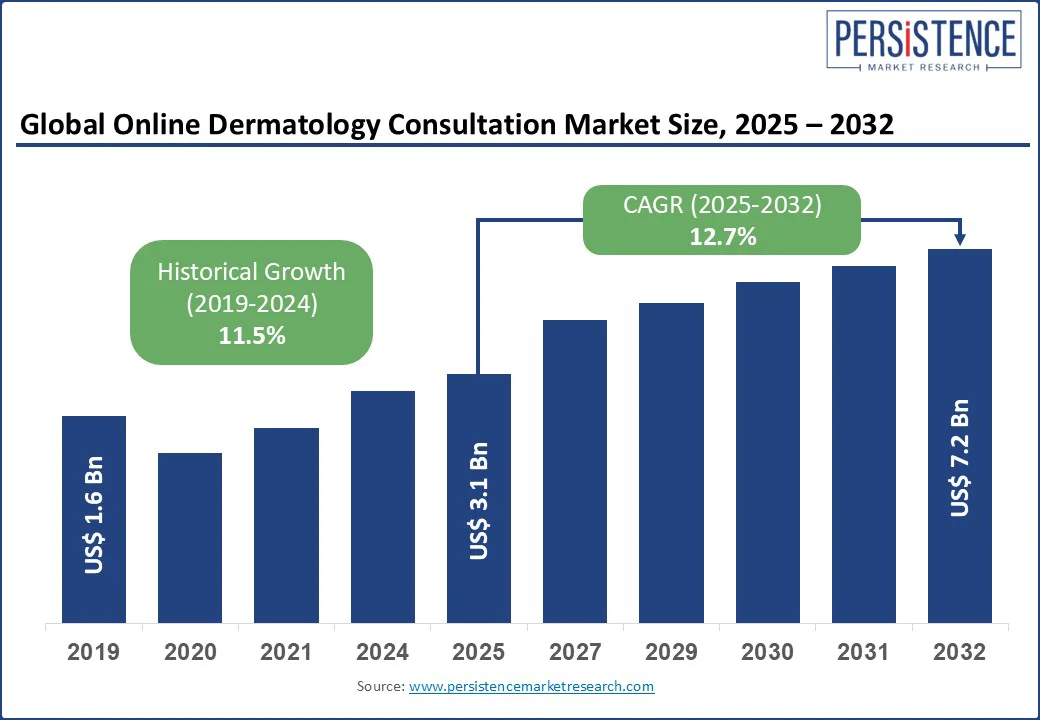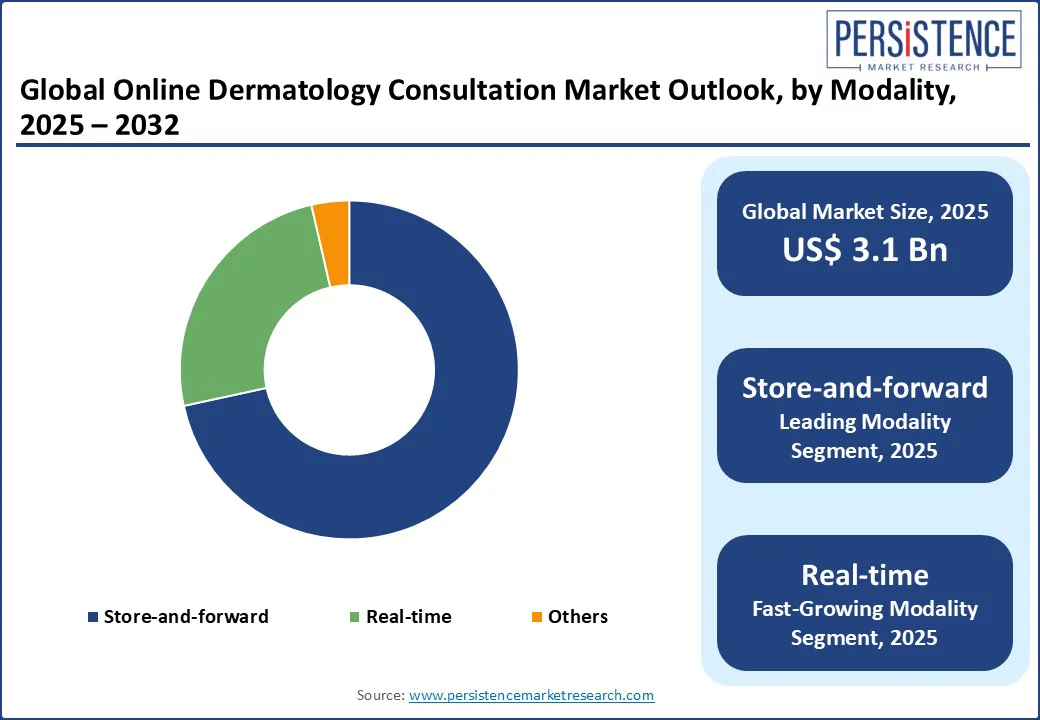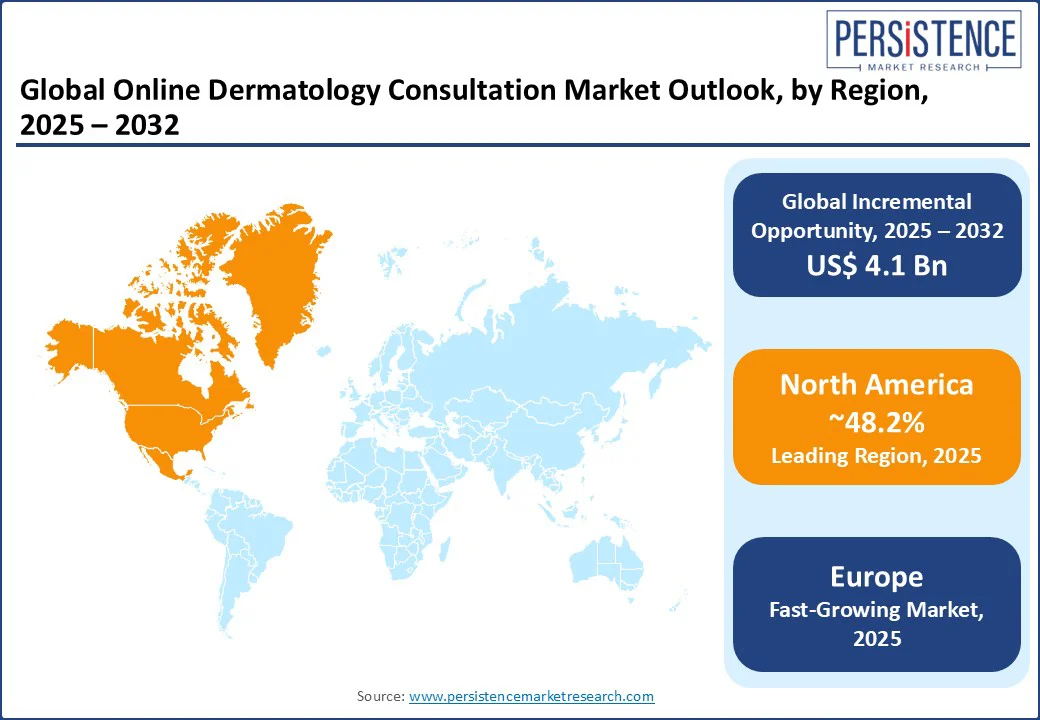ID: PMRREP35540| 195 Pages | 1 Aug 2025 | Format: PDF, Excel, PPT* | Healthcare

The global online dermatology consultation market size is likely to be valued at US$ 3.1 Bn in 2025 and is estimated to reach US$ 7.2 Bn in 2032, growing at a CAGR of 12.7% during the forecast period 2025-2032. The online dermatology consultation market growth is driven by the increasing prevalence of skin conditions, the shortage of dermatologists, the widespread adoption of telemedicine, and advancements in digital health technologies. Online dermatology consultation has rapidly evolved from a pandemic-era workaround into a technologically developed solution transforming dermatological care delivery.
Consumers are increasingly prioritizing convenience, speed, and privacy when managing skin health. Digital dermatology platforms are capitalizing on AI-based diagnostics, asynchronous consultation models, and D2C prescription services. These platforms are further showcasing robust adoption not only from tech-savvy individuals but also from healthcare institutions and corporate wellness programs.

Key Industry Highlights
|
Global Market Attribute |
Key Insights |
|
Online Dermatology Consultation Market Size (2025E) |
US$ 3.1 Bn |
|
Market Value Forecast (2032F) |
US$ 7.2 Bn |
|
Projected Growth (CAGR 2025 to 2032) |
12.7% |
|
Historical Market Growth (CAGR 2019 to 2024) |
11.5% |
The increasing prevalence of skin diseases is significantly boosting the online dermatology consultation market growth. Conditions such as acne, eczema, psoriasis, melasma, and fungal infections are surging due to pollution, dietary changes, hormonal imbalances, and stress. A 2024 report by the American Academy of Dermatology found that over 50 million individuals in the U.S. suffer from acne annually. Digital-native Gen Z and millennials show a surging preference for virtual dermatology platforms for both diagnosis and treatment continuity.
The Indian Association of Dermatologists, Venereologists and Leprologists (IADVL) also reported a 35% rise in dermatology-related Outpatient Department (OPD) cases in the post-pandemic period, with about 40% of those related to fungal and pigmentation disorders. Many of these are now first addressed through mobile dermatology apps. The global rise in autoimmune skin conditions such as psoriasis and atopic dermatitis has also made virtual consultations more appealing.
The lack of personal connection in online dermatology consultations is emerging as a significant barrier. It is mainly evident in patients managing chronic or emotionally sensitive skin conditions. Trust and rapport are essential in dermatology, where visual diagnosis often overlaps with psychosocial distress. A 2023 study published in Telemedicine and e-Health found that 32% of teledermatology users in the U.S. discontinued follow-ups. They reported a lack of emotional engagement and poor communication clarity as key reasons.
The disconnect is even more pronounced among older adults and patients with complex conditions requiring long-term care plans. The emotional reassurance of face-to-face interaction is not replicable through asynchronous platforms or AI-generated recommendations. In culturally sensitive markets, discretion and doctor-patient hierarchy play a key role in medical interactions. In these markets, the impersonal nature of teleconsultations has slowed the uptake outside urban centers.
Corporate wellness programs and the booming interest in cosmetic dermatology are changing the use cases for e-dermatology consultations, opening new revenue streams. Several multinationals across India, Singapore, and the UAE have started incorporating virtual skin health checks into their employee wellness benefits. In parallel, the rise of tele-aesthetic services is redefining how users approach dermatological care, not just for medical requirements but also for beauty and lifestyle goals.
Platforms such as Clinikally and Skinora blend dermatology with personalized skincare regimens, product subscriptions, and follow-up consultations. This shift indicates an overlap between dermatology and consumer wellness, fueling demand for accessible skin enhancement solutions. The proliferation of D2C cosmeceutical brands, including Minimalist, Foxtale, and Dr. Jart+, has further created a new marketing pathway for online dermatology. Brands now collaborate with licensed dermatologists through telemedicine platforms to validate skincare routines.
By modality, the market is bifurcated into store-and-forward and real-time. Among these, the store-and-forward segment will likely hold around 71.6% share in 2025 due to its ability to overcome time-zone, bandwidth, and scheduling constraints. This model enables patients to upload images and descriptions of their skin issues, which dermatologists can review and respond to later. The format is highly efficient for non-urgent conditions such as acne, rashes, and eczema, where high-resolution images often provide sufficient diagnostic input.
Real-time modality is predicted to witness a steady growth rate through 2032 owing to its ability to cater to patient expectations for immediacy, interactivity, and reassurance. This model allows live video consultations, enabling dermatologists to ask follow-up questions, assess patient history in real time, and make appropriate judgments. Real-time consultations are also becoming the preferred option in pediatric dermatology and geriatric care, where caregivers require immediate guidance. In regulated healthcare markets such as Australia, real-time dermatology is gaining traction due to insurance-linked reimbursement policies.
Based on end-use, the market is divided into healthcare facilities and homecare. Out of these, the homecare segment is poised to account for nearly 70.4% of the share in 2025 owing to the surge of skin concerns that do not require in-clinic intervention and self-directed healthcare behavior. Consumers increasingly seek accessible solutions for non-emergency skin conditions, which are often chronic and can be managed remotely with personalized regimens. This shift is further fueled by the rising popularity of D2C skincare platforms that integrate dermatology services as part of their product ecosystem.
Healthcare facilities are seeing considerable growth owing to the strategic role of skin teleconsultation services in integrating teledermatology into formal care pathways. Hospitals and clinics are increasingly adopting teledermatology to improve triage efficiency, reduce waiting times, and enhance referrals. This growth is also tied to the ability of healthcare systems to incorporate AI-backed diagnostics into clinical workflows. In addition, academic and tertiary care hospitals are increasingly using teledermatology for research, training, and population-level screening.

In 2025, North America is expected to account for approximately 48.2% of share due to its rapid transition from a pandemic-induced necessity to a mainstream service across private and public healthcare ecosystems. The U.S. online dermatology consultation market is estimated to dominate as platforms such as DermatologistOnCall provide subscription-based models that combine virtual consultations with prescription dermatology drugs. These platforms are also increasingly adopting hybrid care models, where AI-based image analysis initiates the consultation.
Canada has seen more integration in the public health system. Provincial telehealth programs, including Ontario’s Teledermatology initiative, are streamlining referrals between general practitioners and dermatologists through secure digital platforms. This system reduced referral wait times from over six months to under six weeks, especially in rural and indigenous communities. Platforms such as DermCafé and Tia Health have also gained traction, offering licensed dermatologists across provinces with bilingual services and insurance support.
In Europe, the market is characterized by high regulatory fragmentation and country-specific digital health adoption. Germany, for example, has emerged as a key market following the 2022 expansion of the Digital Healthcare Act (DVG). It reimburses digital health applications (DiGAs), including teledermatology services. In contrast, the U.K.’s National Health Service (NHS) has integrated dermatology into its e-Referral Service (e-RS), but long-standing specialist shortages have created bottlenecks.
The gap has been partially addressed by private digital health providers such as Push Doctor and Livi. These are NHS partners offering paid dermatology consultations with waiting times under 24 hours. Skin Analytics also received MHRA Class IIa certification for its dermoscopic image analysis tool, which is now being used in NHS pilot programs to reduce melanoma misdiagnosis. France and Spain are still in early stages of mainstreaming online dermatology due to slow reimbursement structures and strict rules around digital prescriptions.
Asia Pacific is marked by sharp contrasts between highly digitized markets and rapidly scaling yet underserved regions. In South Korea, the integration of teledermatology into cosmetic dermatology is particularly strong. Platforms such as Seoul TouchUp combine dermatological advice with AI-backed skin analysis and beauty consultations, often linking users directly to clinics. In India, the online dermatology space has expanded swiftly due to urban demand and smartphone penetration.
Accessibility in rural areas, however, remains uneven. Platforms, including Remedo, Tata Health, and CureSkin, are gaining impetus by offering AI-backed preliminary assessments followed by access to certified dermatologists. CureSkin, for instance, reported serving over 6 million users by early 2025, with most consultations focused on acne, pigmentation, and hair loss. Its hybrid model of AI diagnosis with offline product delivery is helping bridge infrastructure gaps. China presents a distinct model where online dermatology is heavily commercialized through platforms such as JD Health and Ping An Good Doctor.

The global online dermatology consultation market is rapidly evolving with strong differentiation emerging based on service depth, AI integration, prescription capabilities, and regional regulations. Leading companies are focusing on asynchronous consultations and AI-powered skincare consultation platforms for triaging cases before routing them to board-certified dermatologists. Start-ups are integrating dermatology with tele-aesthetics, providing personalized skin care treatments directly to consumers. It is shifting the competitive focus from diagnosis alone to full-cycle skin health management.
The online dermatology consultation market is projected to reach US$ 3.1 Bn in 2025.
Increasing lifestyle-induced skin issues and high demand for discreet treatment of stigmatized conditions are the key market drivers.
The online dermatology consultation market is poised to witness a CAGR of 12.7% from 2025 to 2032.
Emergence of hybrid models combining AI triage with dermatologist verification and the integration of multilingual support are the key market opportunities.
Aerotel Medical Systems Ltd., MDLIVE, and Visby Medical, Inc. are a few key market players.
|
Report Attribute |
Details |
|
Historical Data/Actuals |
2019 - 2024 |
|
Forecast Period |
2025 - 2032 |
|
Market Analysis |
Value: US$ Bn |
|
Geographical Coverage |
|
|
Segmental Coverage |
|
|
Competitive Analysis |
|
|
Report Highlights |
|
|
Customization and Pricing |
Available upon request |
By Indication
By Modality
By End-use
By Region
Delivery Timelines
For more information on this report and its delivery timelines please get in touch with our sales team.
About Author